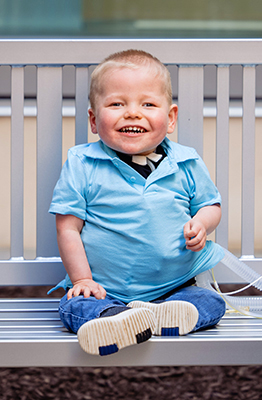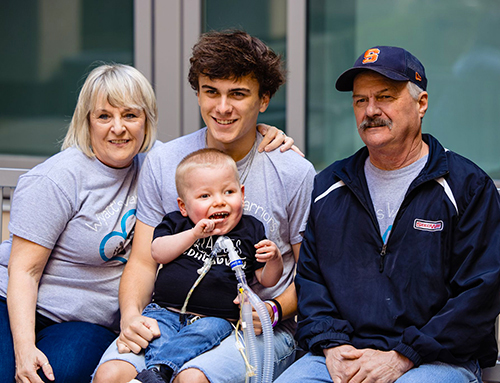Wyatt Robson
A Last Ditch Treatment Saves Newborn with Rare Disease
For Sarah Robson, the hardest and best moments of her son Wyatt’s 422-day hospitalization came within minutes of each other as the four-week-old’s health failed one night in 2018.
 First, the hardest. Wyatt’s care team was gentle but clear: If anyone hadn’t met Wyatt yet, now was the time. He might not survive the night.
First, the hardest. Wyatt’s care team was gentle but clear: If anyone hadn’t met Wyatt yet, now was the time. He might not survive the night.
Then, the best. Derek Wakeman, M.D., assistant professor of Surgery and Pediatrics, had one more idea—a long shot, but a chance. The hope that had sustained the family surged again. With the support of Wyatt’s care team, they decided to try.
“The level of expertise in that hospital is incredible,” Robson said. “You hear about Golisano, but the experience of actually being there is something entirely different. The nurses, the doctors and everyone working on the floors are second to none. Every medical decision they made, they made as a team, and they included the family.”
Choosing Hope
Today, Wyatt is a ball of energy who recently took his first trip to the zoo. Major health challenges remain, but by simply living he defied the odds. He was born with a condition called CDH, and his case was so severe that he had less than a one in four chance of survival.
Robson, her significant other Jeff, her teenage son Noah, and her mother first heard the term CDH after Wyatt’s 20-week ultrasound. It stands for Congenital Diaphragmatic Hernia, and it occurs when the diaphragm doesn’t close properly. As a result, organs like the intestines and liver move into the chest, putting pressure on the heart and lungs, which no longer have room to develop well, explained Kristin Scheible, M.D., associate professor of Pediatrics, who helped care for Wyatt.
“These babies can get into dire straits very quickly at birth,” she said.
Noah had come to the ultrasound so he could plan a gender reveal party for the family back home in Geneva. But instead of celebrating, they found themselves with emotional decisions to make.
“We said ‘we have two choices: We can feel sorry for ourselves, or we can have hope that everything is going to work out as it’s supposed to,’” Robson said. “We chose to have hope.”
After touring the NICU at Golisano, she and her family decided to remain in Rochester rather than seek treatment elsewhere.
“I knew this was exactly where I needed to be,” Robson said. “They were going to give us that hope we needed. They were going to do everything they could do for Wyatt.”
No one went into that process with any illusions.
Along with CDH, Wyatt had several chromosomal abnormalities. The road ahead would be hard.
“I can’t overemphasize the intensity of the treatment that Wyatt required,” Scheible said. “He and his family were pioneers in saying ‘yes, let’s try it.’ Some families might push for treatment without a realistic sense of the odds, but this family had their eyes wide open.”
Robson was in an out of the hospital several times. The team at Golisano encouraged her to focus only on the next week, and making it through that. With their support, she made it to 39 weeks gestation.
The Mayor of the NICU
Wyatt arrived on June 4, 2018, and his first days were as challenging as expected. Like many CDH babies, he initially did well on a ventilator but then needed the additional support provided by ECMO, which is essentially a heart/lung bypass machine.
By day 19, Wyatt had stabilized enough for surgeons to repair his hernia and move his organs back into their correct locations in his abdomen. Wyatt wasn’t yet big enough for surgeons to close the incision over them, so he was left with what’s called a silo—effectively, a patch over the still-open surgical site—and taken off of ECMO.
Wyatt did well for about a week. And then came what Robson remembers as the hardest and best night as Wyatt slipped into heart and respiratory failure. Wakeman’s last-ditch solution was a type of ECMO not typically done at Golisano. Standard ECMO uses a vein and an artery. Wakeman proposed a type of ECMO that uses only veins. To make it work, he had to re-access a tied-off vein from the earlier ECMO much closer to the heart.
“Dr. Wakeman said he wasn’t ready to give up,” Robson recalled. “If someone was willing to give us any hope, we were ready to jump on it. But he was very clear that he couldn’t promise anything—he said he had done the procedure three times, and two patients had ended up surviving.”
Happily, Wyatt became patient number three. Although he coded several times, he gradually improved and was able to go off ECMO and back to standard ventilation after three weeks. On Aug. 31, doctors were at last able to close his abdominal wall.
Wyatt’s care team next focused on other issues caused by his condition—pulmonary hypertension, unstable stress hormones, problems with his digestive system and more. Many times, Scheible and other members of the team would try something new and commit to remaining at his bedside for the following 24-36 hours to see if it worked.
“We approached it all with an open mind,” Scheible said. “We knew we were trying everything we could: We weren’t going to leave anything on the table.”
His care involved nutritionists, respiratory therapists, occupational therapists, musical therapists, hematologists, cardiologists, the palliative care team, anesthesiologists and more. Scheible credits that team approach—the kind of collaborative care that can only happen at a place like Golisano—for the successful outcome.
Wyatt ultimately spent six months in NICU, long enough for him to be nicknamed the mayor and to don an appropriate costume for Halloween. When he moved to PICU, they joked they’d have to upgrade his title to governor. His family decorated his rooms and at times practically moved into the hospital.“
 His family was so amazing and patient and optimistic,” Scheible said. “When he was finally able to go home, we all felt like his family was our family. I have rarely been so confident that a baby this medically fragile was going to thrive at home.”
His family was so amazing and patient and optimistic,” Scheible said. “When he was finally able to go home, we all felt like his family was our family. I have rarely been so confident that a baby this medically fragile was going to thrive at home.”
Going Home, Growing Strong
Scheible’s intuition was correct.
“He loves being home,” Robson said. “He’s the happiest baby I’ve ever seen. He loves being outside, loves riding in his Daddy’s tractors—he just really enjoys life. He’s a little spitfire—that’s what got him through."
It has been a year since the family had to take an unplanned trip to the hospital. Wyatt has started eating—something no one was sure he’d be able to do. Robson still texts his care team at Golisano with regular updates.
“He has a long way to grow and has challenges ahead, but he has an amazing medical team and amazing parents behind him,” Scheible said. “He has the best chance possible for any baby in his situation. When you see how far he has come, it just gives me hope that he is going to progress and achieve his full potential.”
Robson believes that, too. And she and her family would do it all over again.
“Good things come from bad situations, and Wyatt is proof of that,” she said. “CDH is now just part of who Wyatt is. It’s part of our family.”